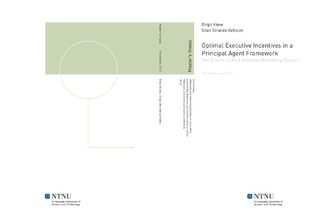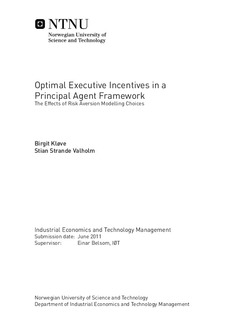| dc.contributor.advisor | Belsom, Einar | nb_NO |
| dc.contributor.author | Kløve, Birgit | nb_NO |
| dc.contributor.author | Valholm, Stian Strande | nb_NO |
| dc.date.accessioned | 2014-12-19T14:27:45Z | |
| dc.date.available | 2014-12-19T14:27:45Z | |
| dc.date.created | 2012-01-06 | nb_NO |
| dc.date.issued | 2011 | nb_NO |
| dc.identifier | 473585 | nb_NO |
| dc.identifier | ntnudaim:6304 | nb_NO |
| dc.identifier.uri | http://hdl.handle.net/11250/265951 | |
| dc.description.abstract | In order to determine the structure of the optimal CEO contract, we create a principal agent model and implement it on a sample of Norwegian firms. The model takes account of executives loss‐ and risk‐aversion and the fact that undiversified and risk‐averse executives do not put the same value on stock options as shareholders do. We employ the certainty equivalent approach in determining the perceived value of the CEO s stock options and conduct a comprehensive numerical computer simulation to determine the optimal CEO contract.Our analysis delivers four important findings. First, our results show that the option s exercise price of long term option grants does not affect executive performance in the optimal contract. When awarding the executive premium or at‐the‐money options, we find similar CEO performance and contracts cost for long term options grants. Premium options do however have a lower incentive effect. At‐the‐money options must therefore be substituted with larger amounts of premium options to induce the same level of effort.Second, the CEO s ability to affect the firm outcome has a large impact on the optimal contract. As the executive s action has an increasing impact on the firm performance, the marginal incentive effect from equity awards increase. This results in higher levels of effort and cheaper contracts.Third, our results indicate that Norwegian firms suffer large agency costs as they fail to present executives with optimal contracts. Norwegian executives should receive more stocks and options and a lower base salary. This tradeoff would involve a transfer of risk from the shareholders to the executive, resulting in a higher total compensation due to the CEO s need for a risk premium. The increase in executive compensation is however more than outweighed by the increase in CEO effort and shareholder return. We also find it to be optimal from the shareholders view that executives invest more of their personal wealth in the company.Finally, we show that our model is a good predictor of CEO performance. When we run our model for the actual CEO contract of the sample firms, we predict a performance close to the observed level. This suggests that executives indeed are risk‐ and loss‐averse. We propose some societal constraints on the magnitude of the executive compensation in Norway in an attempt to explain why firms fail to present executives with optimal performance incentives. | nb_NO |
| dc.language | eng | nb_NO |
| dc.publisher | Institutt for industriell økonomi og teknologiledelse | nb_NO |
| dc.subject | ntnudaim:6304 | no_NO |
| dc.subject | MTIØT Industriell økonomi og teknologiledelse | no_NO |
| dc.title | Optimal Executive Incentives in a Principal Agent Framework: The Effects of Risk Aversion Modelling Choices | nb_NO |
| dc.type | Master thesis | nb_NO |
| dc.source.pagenumber | 117 | nb_NO |
| dc.contributor.department | Norges teknisk-naturvitenskapelige universitet, Fakultet for samfunnsvitenskap og teknologiledelse, Institutt for industriell økonomi og teknologiledelse | nb_NO |

